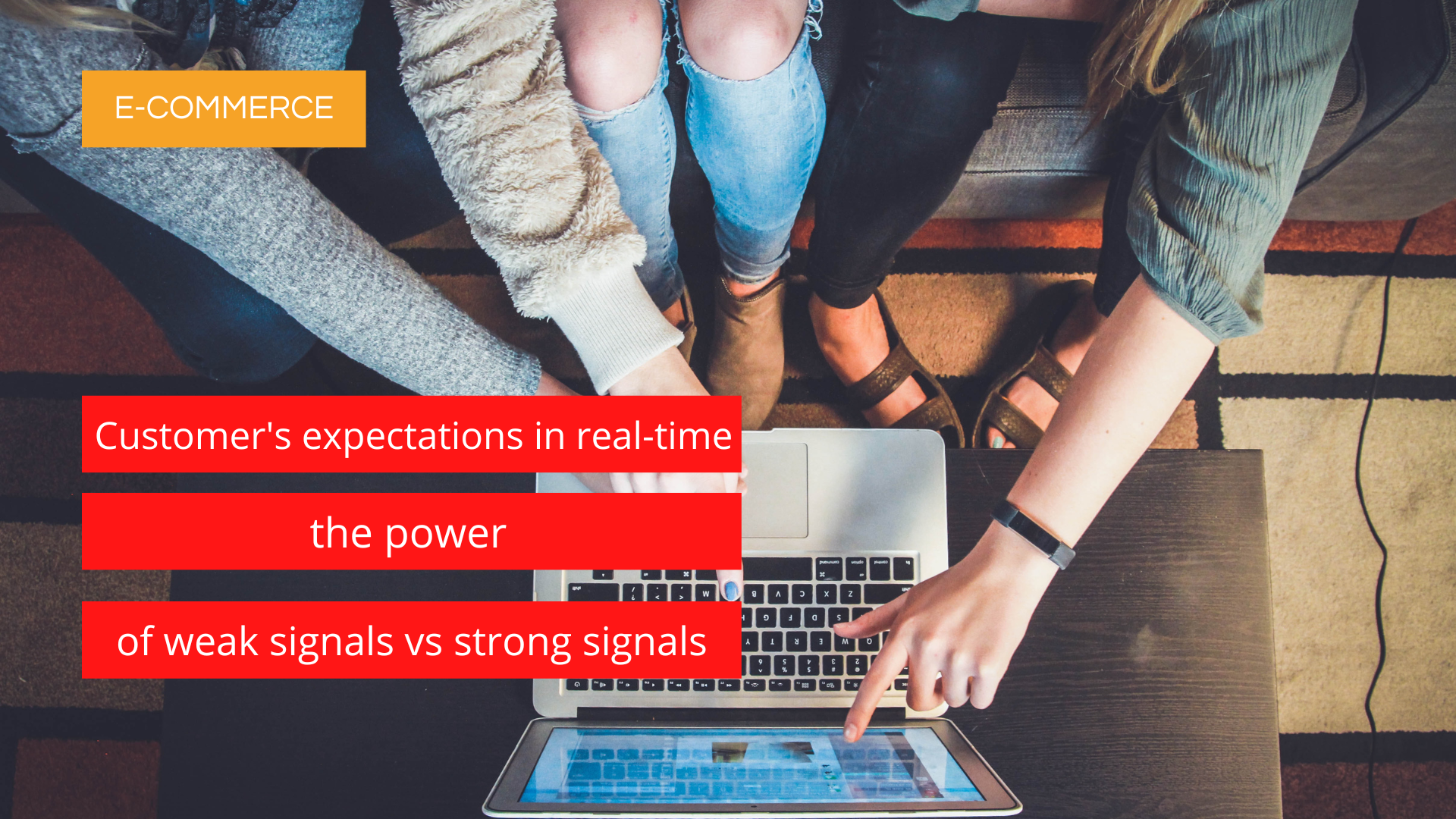
Understanding a customer's expectations in real time to offer personalized suggestions: it's every e-commerce site's dream! However, knowing which aspects to consider when personalizing the customer experience is difficult. Should you focus on strong signals? Weak signals? How to take them into account? Debunked.
Weak signal, strong signal: what are the differences?
Strong signal: a clear expression of the need
Strong signal: definition
A strong signal is a direct information, often explicit. The customer expresses his need, usually by providing a solution.
Strong signal: example
A man enters a tv store and speaks to the first salesman he meets: "Hello, I'm looking for a high-end video projector to put in my home cinema room." The expectation is here clearly expressed.
Weak signal: an indirect information
Weak signal: definition
A weak signal is an indirect information, often implicit, which, when crossed with other weak signals, allows us to presume the need and the solution adapted to this need.
Weak signal: example
A man enters a tv store. He is dressed in designer clothes (implicit signal), wears an expensive watch (implicit signal), goes to the video projector section (explicit signal), and seems to be interested in high-end equipment (explicit signal).
Although expressed differently in the two examples, the need is the same.—a person looking for a solution to a large, high-quality image.
The limits of strong signals
The "strong" signal has 3 major drawbacks.
1.Increasing the level of compromise
The strong signal forces the client to express and assert his need, generally in the form of a solution. However, this explicitness increases the level of compromise the customer asks for, even if this compromise is motivated by his satisfaction. In other words, if the customer expresses that he is looking for a high-end projector, the salesman (physical or online) will have difficulty convincing him to turn to another solution, even if this one is more advantageous or corresponds better to his need. This is because the strong wording forces the customer to express the solution he wants: it reinforces his conviction. It will then be more difficult to redirect his purchase to meet his need if the solution initially considered is not the most suitable.
An American marketing theory from the 1980s revealed that increasing the level of compromise required of the consumer to satisfy him was a competitive devaluation factor. The more you ask your potential customer to compromise, the more you reduce your chances of conversion. The stronger the formulation, the higher the understanding required. In other words, the less you can spontaneously understand your customer's expectations, and the more you ask him to express them explicitly, the more you increase your risk of not selling.
On the other hand, observing weak signals allows you to draw valid conclusions about your visitor's expectations without forcing him to express them. This way, you reduce the compromise you are asking them to make. How satisfying it is to be understood "by half a word," as the saying goes! Your ability to understand your customer's expectations without soliciting them increases your chances of success.
2. Increasing the complexity of the vendor's work
This limit emanates from the previous one. The strong signal is commonly addressed in the form of a solution, an affirmation. This direct formulation can then be polluting. At the very least, it can force the salesperson to redouble their efforts to steer the customer towards a solution other than the one initially envisaged - if there is a better solution.
In our first example, the potential customer states his desire to acquire a high-end video projector. However, if we consider the need from which this solution results, "to benefit from a large format and high-quality image," other solutions can be regarded, some of which may even be more efficient than the video projector. When the salesman perceives the real need behind the strong signal expressed, he can, for example, present to the customer a large flat screen solution (100 inches) that offers a better image quality than the video projector, with a similar format. The salesman answers here more to the customer's need but must argue to convince. It is not easy to convince the customer that the best solution is to buy a video projector.
Beyond this situation, the strong signal can even prevent the salesperson from discerning the actual need (a large and high-quality image) behind the expressed need (a high-end projector). The customer's fundamental need may not be considered when it could be better satisfied through the widening of the field of possibilities and the consideration of the 70-inch flat-screen, which offers better image quality, avoids installation works, and maximizes the conditions of use in the middle of the day... The strong signal forces the customer to express his need and may prevent the widening possibilities regarding sales answers. Contrary to what one might think at first glance, the strong signal does not provide absolute certainty and penalizes sales performance.
In short, the strong signal complicates the salesperson's work because it obscures the customer's real need, leaving only the expressed need visible. On the other hand, reading the customer's expectations based on weak signals minimizes the possible pollution of the strong signal. It maximizes the possibility of opening up the field of options and, therefore, sales effectiveness.
3.The non-distinction of individual needs
Finally, strong signals are standard. They do not address a need in that it is individual. All potential customers who express the need to buy a video projector are not alike and do not buy the same product. However, the strong signal "I am looking for a high-end projector" remains the same. It does not allow us to distinguish them or understand their real need efficiently and reasonably.
If the marketing approach only considers the strong wording, the signal will be the same for 99% of potential projector customers. This would imply that recommendations based only on strong signals would work a priori on 99% of these potential customers. This is not the case.
If the expressed need is common, the actual need and the adapted solution are individual. This is why strong signals are lacking.
Weak signals make it possible to distinguish and differentiate potential customers as individuals rather than segments. It then becomes possible to provide individualized, tailor-made, and effective responses to each.
Sales performance, the importance of taking into account strong and weak signals
Strong signal: a necessary indication
If strong signals can be challenged for their limitations (we have not been without them), they should not be dismissed from your sales strategy! A salesperson needs strong signals, whether physical in a store or virtual in e-commerce. They are the ones that will allow him to identify the potential customer's research and to know if he is interested or not in a given product to be able to advise him with relevance. Strong signals are a basis, a reference, but never an end.
Weak signal: an individual understanding of the need
Based on the strong signals, the salesperson must individualize their analysis of the customer's needs to understand their specificities. He will then use the weak signals to understand the differences between this individual customer and the other customers sharing the same strong signal. If this consideration for the individuality of each potential customer is done naturally in physical stores (analysis of the clothes worn, the socio-professional category, the vocabulary, the tone, the posture...), it is not the e-commerce case. However, the personalization of the online customer relationship is all the more critical as it is initially disintermediated. The e-consumer carries out his purchasing process autonomously but still requires a customized service. E-commerce sites must therefore be able to capture each Internet user's strong and weak signals to understand his real needs and accompany him throughout his journey.
- Is the visitor hesitant or not?
- Is it sensitive to the opinions of others?
- Does it use an iOS system? Android? Windows?...
- Does he visit from an area with an arid climate? Continental? Equatorial? Tropical?...
- Is he an evening buyer? A morning buyer? A weekend buyer?
- Does he visit when the weather is good? When it rains? When it's freezing?
- Is it interested in innovative products? Rare?
- Is it sensitive to promotions? to suggestions?
Considered one by one, these weak signals do not give much information about the visitor's actual need. Taken together, they constitute a significant situation that allows us to grasp the individuality of the visit in that it is different from other visits presenting the same strong signals. Thus, it becomes possible to bring a relevant answer rather than a unique solution for 99% of the customers looking for a video projector.
Strong and weak signals: an obvious complementarity
If the e-commerce site of the distributor Son & Image proposes 20 video projectors in assortment, 4 references likely generate 50% of the sales. However, the 15 other references also represent 50% of the sales. A suggestion based only on the strong signals would undoubtedly present the 4 most sold references. The site would then miss out on the other half of the sales for not having been able to respond to customer expectations. This would still mean dividing the conversion rate by 2!
Weak signals allow you to understand the fundamental differences between visitors with the same strong signals to offer them the product that specifically meets their real needs. When using strong and weak signals, your interactions must be relevant, and they must match your visitor's expectations and not a probability on a segment of several tens of thousands of individuals... which has nothing individual about it and is not efficient at all!
Netwave: understanding the visitor in real time for a relevant and efficient recommendation
Netwave makes personalized product recommendations for each visitor to your e-commerce site. Based on Inductive Artificial Intelligence technology, our solution interprets many weak signals to reproduce what works best with visitors who are most like the current visitor, as an individual rather than part of a segment whose centre of gravity is more or less distant.
With its 232 trackers that consider visitors' context, behaviour, and psychology, it helps e-commerce sites acquire new customers and increase their sales. In concrete terms, to produce an individualized recommendation of 4 products, Netwave determines in real time the last 4 visits that are similar to the current visit by valuing the distance between the current and previous visits. Thus, only the most similar visits are used as a reference base to generate personalized insight.
A technology based on the observation and understanding of weak signals through situational analysis, Netwave focuses on reducing the compromise and increasing the chances of finding an answer to the "need behind the need." This way, you meet the real need of each visitor and offer a truly personalized and relevant experience, which maximizes your chances of conversion.
The result? Up to 392% outperformance in an A/B test against a historical leader in product recommendation.


